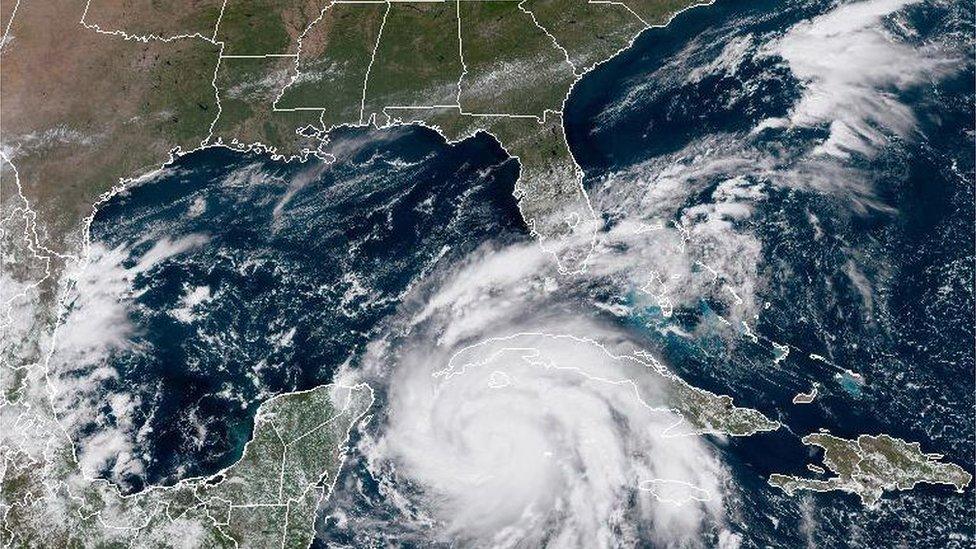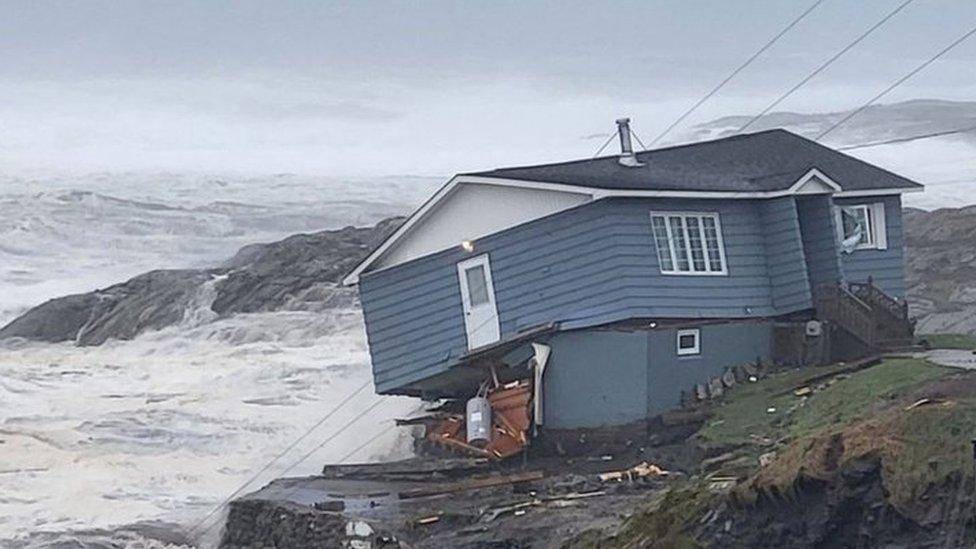Hurricane Ian: Cuba begins restoring power after storm
- Published
Watch: Lightning strikes surround the eye of Hurricane Ian
Power has been restored in parts of Cuba after Hurricane Ian pummelled the western end of the island and caused a total blackout.
Officials earlier said the electrical system had collapsed after one of the country's main power plants could not be brought back online.
Two people were reported dead and buildings were damaged nationwide.
More than 20 Cuban migrants are believed to be missing at sea.
As Ian began to bear down on Florida with winds of up to 250km/h (155mph), US Border Patrol and the US Coast Guard said that a search and rescue operation had been launched to look for 23 migrants whose boat is believed to have sunk at sea during the storm.
Another four migrants made it to shore at Florida's Stock Island. The previous day, seven migrants were apprehended after reaching the US coast at Pompano Beach, prompting Walter Slosar, the chief patrol officer of the Border Patrol's Miami sector, to warn Cubans to not attempt the treacherous crossing during the hurricane.
On Cuban state television on Tuesday, the head of the electrical energy authority announced that an island-wide blackout had occurred as a result of the national electrical system's breakdown, leaving 11 million people in the dark.
A journalist with a state-run news agency reported that "the Antonio Guiteras thermo-electric power plant… could not be synchronised". Based in Matanzas, 100km east of the capital Havana, Antonio Guiteras is the most important energy plant in Cuba.
The blackout also meant that water was unavailable in many areas which rely on pumps, leaving residents unable to bathe or boil water to drink. Food in some areas was reportedly spoiling without functioning refrigerators and freezers.
Working overnight, authorities began gradually restoring service in eastern regions by Wednesday morning although they warned the process would be more "complicated" further west.
Officials later said power had been restored to three regions, but work was ongoing to restore electricity in others.

The storm devastated Pinar Del Rio province, home to much of the tobacco used in Cuban cigars.
The owner of the famous Finca Robaina cigar producer posted photos on social media of the havoc wreaked by the hurricane in the tobacco farms.
"It was apocalyptic, a real disaster," wrote Hirochi Robaina.
Forecasters had warned that some regions of Cuba could see up to 30cm (12in) of rain under Hurricane Ian.
Mayelin Suarez, a resident of Pinar del Rio, said Monday night, when the storm hit, was "the darkest of her life".
"We almost lost the roof off our house," she told Reuters. "My daughter, my husband and I tied it down with a rope to keep it from flying away."
Cuban President Miguel Diaz Canel visited the province and vowed that it would rise "above adversity", the Cuban presidency tweeted.


A 43-year-old woman in the province was killed after the walls of her home collapsed. A farmer in the town of San Juan y Martínez was electrocuted while trying to shut off a wind turbine used for irrigation, the New York Times reported.
Cuban state television channel Canal Caribe said that a total of five buildings had collapsed and 68 were damaged. The report did not specify how many of those structures were residential homes. The storm also felled about 1,000 trees.
The hurricane has been gathering force in the south-eastern Gulf of Mexico after making landfall in Cuba as a Category 3, says the US National Hurricane Center (NHC).
On Tuesday night the storm passed over the Florida Keys, a string of islands off the southern tip of the state.
It was projected to make landfall on Florida's west coast late on Wednesday.
The Florida coastal zone most at risk is home to miles of beach, resort hotels and mobile home parks. Some 2.5 million people are under evacuation orders.

A satellite image of the storm
Florida Governor Ron DeSantis warned in a news conference on Tuesday that the storm is "the real deal".
He declared a state of emergency for all of Florida over the weekend and has activated 5,000 National Guard troops.
Earlier forecasts suggested the Tampa area could see its first direct hit from a hurricane in more than a century, but forecasters now predict Ian will make landfall further south on the coast.
Meteorologists have said flash flooding is possible in the Florida peninsula and Florida Keys as the hurricane approaches.
The neighbouring state of Georgia has also declared a state of emergency and placed 500 National Guard troops on standby.
Watch: Florida braces for Hurricane Ian
The White House has made its own emergency declaration, which will help federal and state officials co-ordinate disaster relief and assistance.
President Joe Biden, a Democrat, spoke with Gov DeSantis, a Republican, on Tuesday evening, and the two committed to "continued close co-ordination", the White House said.
The Caribbean is still reeling from the effects of Hurricane Fiona, which tore through the region last week.
Moving northward to parts of the Atlantic Canada coastline and eastern Quebec, Fiona claimed two lives, washed homes into the sea and downed power lines over the weekend.
- Published25 September 2022

- Published25 September 2022

- Published27 September 2022
